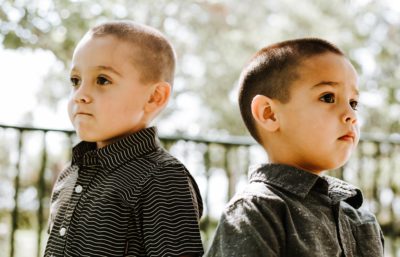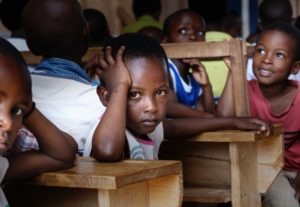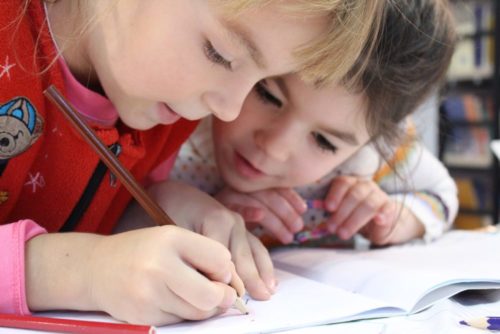 Laughter, running, jumping, being silly, twirling, smiling, creating—all are part of play and having fun! Instinctively, as parents and teachers, we know the importance of play for our kids (and ourselves)—it gives them/us a welcome break from stress and promotes mental health. Yet, we often put play last after homework, sports, jobs, and the constant daily routines of life. The American Academy of Pediatrics promotes play as essential to a child’s development because research shows that it improves learning, cognitive awareness, physical, social, and emotional wellbeing. Fortunately, play is making a comeback because we are remembering how critical it is to healthy brain and body development. Play gives kids tremendous learning opportunities, including how to work with others, manage feelings, think, plan, make decisions, and read other people’s emotions. Play also promotes physical fitness, creativity, self-expression, self-regulation, and healthy boundaries—basically physical and emotional wellness and mental health!
Laughter, running, jumping, being silly, twirling, smiling, creating—all are part of play and having fun! Instinctively, as parents and teachers, we know the importance of play for our kids (and ourselves)—it gives them/us a welcome break from stress and promotes mental health. Yet, we often put play last after homework, sports, jobs, and the constant daily routines of life. The American Academy of Pediatrics promotes play as essential to a child’s development because research shows that it improves learning, cognitive awareness, physical, social, and emotional wellbeing. Fortunately, play is making a comeback because we are remembering how critical it is to healthy brain and body development. Play gives kids tremendous learning opportunities, including how to work with others, manage feelings, think, plan, make decisions, and read other people’s emotions. Play also promotes physical fitness, creativity, self-expression, self-regulation, and healthy boundaries—basically physical and emotional wellness and mental health!
Global Play Labs
There are organizations all over the world embracing the forgotten benefits of play. In Bangladesh, they have created play labs for kids in poorer communities who aren’t exposed to the benefits of preschool and early learning. The World Bank is watching and adding billions of dollars to these resources to help bring a play curriculum to underprivileged kids all over the world. Research has shown that investing in a child early will promote brain development and improve their abilities later in life.
Global School Play Day
There is even a Global School Play Day on February 5th each year where kids take an entire day off school and just play! Teachers do not guide the play, the students do—only rules for safety and that’s it—just play! Imagine how important these days are for stress relief, interpersonal interaction, and just understanding life.
Therapeutic Play
Play can also be very therapeutic for children struggling with difficult life experiences. Doing something completely different, getting away from a difficult situation, or giving a child the opportunity to process the scenario that’s been difficult by acting it out in play will support a child’s mental health. A friend who had a hospitalized premature infant said her girls often played “hospital,” because having their sister hospitalized was so difficult for them. If your kids are stressed or acting out their trauma in play, don’t try to fix it or guide it in a certain direction, let them play it out (as long as they are safe)— eventually they will master or resolve the issues they are working on. If you have concerns about them or what you see, talk to your pediatrician or consult a therapist.
Teaching your child (or yourself) to play
Many of us didn’t grow up understanding how to play so it can be hard to teach and encourage your child to play. But the cool thing is that children naturally know how to play, and you can follow their lead and have fun doing it! The first step is to find out what your child likes to do. This may change over time, so be flexible. Some kids might like cool science experiments, some only want to do something physical and outdoors, others may have music interests, want to cook with you, draw or create—the list is endless, but try to avoid video games—more can be learned without a screen! Instead provide the raw materials your child needs to pursue their interests, explore their imaginations, experience the world around them, or express their creativity.
Ideas for Play
Here are some suggestions for games to play with students/kids. They will help with physical and emotional wellness.
• Chase bubbles.
• Have a picnic (indoors or out).
• Play hide-n-seek.
• Card or board games.
• Puzzles
• Decorate cookies together.
• Guess the mystery food.
• Have a pillow fight.
• Cut snowflakes out of paper.
• “I see something in Grandma’s grocery store and
it starts with the letter ___.”
• “I spy with my little eye, something that is (name
a color). Guess what it is!”
• Play music, dance, and freeze—see how silly
everyone looks!
If you or your child is struggling with stress or an event in their life that has been difficult, play can be a perfect outlet. Sometimes they may need to talk or write about their feelings before they can let go and play. Using The Imagine Journals will help them process what is making them feel down, sad, mad, etc. Try doing The Imagine Project with your classroom or in your family to help support their mental health and bring them back to a place they can run, jump, and laugh again. For more information on stress and trauma in kids you can read The Imagine Project: Empowering Kids to rise above Drama, Trauma, and Stress (Yampa Valley Publishing, 2018) You can download the free journals at www.theimagineproject.org)
Thank you and happy playing!
Dianne

 Stress is a normal, unavoidable part of life. It’s actually good for a child to experience small amounts of manageable stress, such as frustration with learning a new skill, dealing with being late to a birthday party due to traffic, or worrying about saying the wrong line in a school play. Learning to deal with the minors stressors of life as a child, when a parent is around to teach them healthy coping skills, will support them as they grow and face more difficult life challenges.
Stress is a normal, unavoidable part of life. It’s actually good for a child to experience small amounts of manageable stress, such as frustration with learning a new skill, dealing with being late to a birthday party due to traffic, or worrying about saying the wrong line in a school play. Learning to deal with the minors stressors of life as a child, when a parent is around to teach them healthy coping skills, will support them as they grow and face more difficult life challenges.

 Tis that time of year again; teachers are trying not to think about going back to school—but, unfortunately, it’s creeping up on your horizon. There are mixed feelings about the up and coming new school year; excitement, dread, curiosity, doubt, hope, and worry are just a few. Where does a teacher begin when he or she is planning for their future 8-10 months with students? How about writing your Imagine Intentions for the school year?
Tis that time of year again; teachers are trying not to think about going back to school—but, unfortunately, it’s creeping up on your horizon. There are mixed feelings about the up and coming new school year; excitement, dread, curiosity, doubt, hope, and worry are just a few. Where does a teacher begin when he or she is planning for their future 8-10 months with students? How about writing your Imagine Intentions for the school year?
 Sadly, anyone with a child, friend, or relative in a school today worries if they will be safe. Unfortunately, the fear of a student being hurt by gun violence has become very real and prevalent. After picking ourselves up from yet another school shooting we have to seriously look at what we can do to help dissolve this horrific issue.
Sadly, anyone with a child, friend, or relative in a school today worries if they will be safe. Unfortunately, the fear of a student being hurt by gun violence has become very real and prevalent. After picking ourselves up from yet another school shooting we have to seriously look at what we can do to help dissolve this horrific issue. Yet another school shooting—ugh—the pain, the anger, the despair, and the confusion. I/we hope this one is different. Could it be the tipping point for students, parents, teachers, and possibly even lawmakers to realize we have some serious issues in our country; issues with the mental health of our children—and gun control? I won’t address the gun control issue here; instead I’d like to focus on supporting the mental health of our children.
Yet another school shooting—ugh—the pain, the anger, the despair, and the confusion. I/we hope this one is different. Could it be the tipping point for students, parents, teachers, and possibly even lawmakers to realize we have some serious issues in our country; issues with the mental health of our children—and gun control? I won’t address the gun control issue here; instead I’d like to focus on supporting the mental health of our children. January is a month for new beginnings. We often dream about what’s possible for the upcoming year creating hopes for new life experiences. Research has proven that defined intentions and goals reap greater success in many areas of life. Yet many don’t think about setting intentions and may not understand how to teach kids to set intentions. An intention is a clear and positive goal regarding what you want to have and experience in life. If you have a distinct end in mind, your thoughts, actions, attitude, and choices will move in that direction. If you don’t have a distinct end in mind, you will stumble and wander without direction.
January is a month for new beginnings. We often dream about what’s possible for the upcoming year creating hopes for new life experiences. Research has proven that defined intentions and goals reap greater success in many areas of life. Yet many don’t think about setting intentions and may not understand how to teach kids to set intentions. An intention is a clear and positive goal regarding what you want to have and experience in life. If you have a distinct end in mind, your thoughts, actions, attitude, and choices will move in that direction. If you don’t have a distinct end in mind, you will stumble and wander without direction. Tis the season to be jolly, overwhelmed, and/or stressed. The holiday season can bring out the best, and sometimes the worst in us. Many people love the holidays: spending time with family and friends, recreating traditions, and feeling a sense of giving are all positive aspects of the holidays. But there are a significant percentage of people who feel more stress around the holiday season. In our already fast paced world, the holidays add more to our list of things to do, which may create unwanted pressure, even overwhelm for some. Then there’s our holiday history from our own childhood. You may be lucky enough to have beautiful memories from your holidays as a child, but many are left with the memories of increased alcoholism, domestic abuse, or the lack of having gifts to open.
Tis the season to be jolly, overwhelmed, and/or stressed. The holiday season can bring out the best, and sometimes the worst in us. Many people love the holidays: spending time with family and friends, recreating traditions, and feeling a sense of giving are all positive aspects of the holidays. But there are a significant percentage of people who feel more stress around the holiday season. In our already fast paced world, the holidays add more to our list of things to do, which may create unwanted pressure, even overwhelm for some. Then there’s our holiday history from our own childhood. You may be lucky enough to have beautiful memories from your holidays as a child, but many are left with the memories of increased alcoholism, domestic abuse, or the lack of having gifts to open.